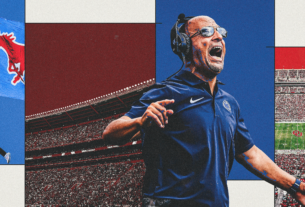NEW YORK — Aaron Judge wanted a change. One of the most feared hitters in the majors, the New York Yankees center fielder had struggled through the first several weeks of the season. By the end of April, he was hitting just .207.
“I wasn’t doing too hot,” he recently said.
So, Judge — who, like many players, often tinkers with his swing — committed to what appeared to be a significant adjustment.
On May 5, he walked to the plate to face Detroit Tigers ace Tarik Skubal with two outs in the first inning. Instead of assuming his usual open batting stance — with his left foot angled toward the third baseman — he switched things up. He slightly closed his stance, pointing his foot more toward the pitcher. He also stood a little straighter.
It worked like a charm. In a 1-1 count, Skubal tried to whip a 97-mph heater down and in to Judge. But he left it over the plate, and Judge crushed it for a solo home run nearly into the bleachers in right-center field at Yankee Stadium.
Judge finished the game 2-for-3 with a double and a walk. Since then, he’s retaken his place as the best hitter in baseball. Going into Monday’s road game with the Chicago White Sox, he was leading in two of three Triple Crown categories, posting an American League-best 42 home runs and 106 RBIs. His .328 batting average, however, was second-best to the Kansas City Royals’ Bobby Witt, who was hitting .347. Judge’s 217 wRC+ — a catch-all metric that measures a player’s overall value — was also the best and more than 30 points higher than his closest competition, teammate Juan Soto, who was at 186.
He was also sitting on 299 career home runs. He’s on pace to be the fastest player to 300.
Judge said the change helped him with several things.
First, he said, it made him feel more comfortable. Second, it allowed him to be more effective against sliders and away pitches in general. Through May 4, Judge was batting just .154 with a .333 slugging percentage vs. sliders. After May 5, he’s hit .348 vs. them while slugging .812.
“Just staying on the away pitch a little better,” he said. “A lot of teams, they love to throw slider away, slider away and then show heaters inside and then slider away — the same thing. Just if I start a little closed or a little more straight up, which is what I usually like to do, I can kind of stay on those a little better.”
He added that it helped his front foot land more consistently where he wanted — pointing almost directly at the pitcher.
“I always want to get back to square when I land,” he said. “But sometimes if I’m starting way out there, sometimes I feel like I never got back to being square, so that pitch away felt even farther. So if I start more square, you have a better chance to stay on some balls.”
Of course, the change wasn’t a one-time adjustment. This season, Judge has at various times stood even more square to the pitcher and he’s occasionally adjusted how tall he stands, all in the name of finding the right balance.
First baseman Anthony Rizzo — one of the best-hitting first basemen in the game since he debuted in 2011 — said he noticed the change in Judge’s batting stance when it happened and said a hitter’s legs can be a key to his success. In workouts before spring training, Yankees players told each other that they wanted to put a season-long emphasis on closely watching each other’s at-bats and helping correct flaws as they arise.
“Hitting is very hard,” Rizzo said. “But I think as long as you have your core foundation and you’re being on time, I don’t think it matters where you start. … It’s a feel thing.”
Judge’s swing has looked more direct since the change, manager Aaron Boone said.
“In a way, it’s just simplified it for him,” Boone said, “and made him really efficient in what he’s doing in the (batter’s) box. Along with that, we’ve seen great swing decisions. He’s real calm up there in how he takes pitches, having an understanding of what he’s looking for and not trying to do too much with it. He knows he doesn’t have to swing harder or add more. He slows it down very well, and I think the stance and the position he’s in — from my standpoint and from my looking at him — allows him to be more efficient.”
Hitting coach James Rowson said it’s not uncommon for even the best players in the game to make significant adjustments in search of feeling more comfortable at the plate.
“I don’t think it’s strange,” Rowson said. “I think if you took 100 hitters, you’re going to see them make adjustments, just because of how something is feeling. It doesn’t mean that’s where you’re going to stay. You could stay there. You could go back. I think as long as he’s getting to that point right now that he’s talking about where he feels like he’s in a good position to make a good move, that’s where we want to be. Sometimes you make those adjustments in order to regain that feeling.”
Lately, Judge has had less of a chance to put his change to work. Teams have once again taken to giving Judge the Barry Bonds treatment — purposely pitching around him or intentionally walking him rather than allowing him to beat them. This season, he’s tied with the Houston Astros’ Yordan Alvarez for the most intentional walks in the game at 13. They also did it to him toward the end of the 2022 season when he set an American League record with 62 home runs.
Still, Judge said he felt good about the move, and that more may come as he continues to search for comfort at the plate.
“There’s certain things that you have to stick the course with and you know things will turn (around),” he said. “But these are the little things where you just watch your tape and analyze your game and little things can stick out and it’s like, well, let me see if this will work.”
A reporter then suggested to Judge that the move had, in fact, seemed to work.
He smiled.
“So far.”
(Top photo of Aaron Judge: Gregory Fisher / Icon Sportswire via Getty Images)





